A SCR (silicon-controlled rectifier) is a three-terminal semiconductor device that behaves like a diode but with an additional terminal.
The additional terminal is called a gate, and when a small current flows into the gate, it allows a much larger current to flow from the anode to the cathode (provided that the voltage between the anode and the cathode is forward biased).
The symbol and a typical component form of a SCR are shown in Figure 1.
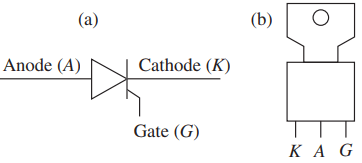
and (b) typical component.
Characteristics of SCR
The current–voltage characteristics of SCR are shown in Figure 2.
When no current is applied to the gate (off state), the current flow between the anode and the cathode in the SCR is negligible for voltages greater than VR and less than VF.
Note that the forward voltage (VF) of a SCR is quite large (from 50 up to several hundred volts), unlike that of a regular diode.
When a small current (mA range) is applied to the gate, the SCR conducts if the voltage applied to it causes it to be forward biased.
When the SCR is conducting (on state), the forward voltage across the SCR is small (1 to 2 V), and the SCR current can be in the several ampere range.
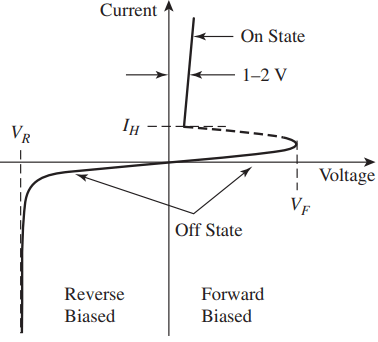
relationship for a SCR.
Note that if the current to the gate is cut off, the SCR continues to conduct as long as the voltage applied to it causes it be forward biased. The SCR is turned off only when the current between the anode and the cathode drops below a certain value called the holding current (IH).
The gate current (IGT) that causes the SCR to conduct is small and is typically a few milliamps or less. For example, for the 2N6401 SCR, VF is 100 V when not conducting and 1.7 V when conducting, IGT is about 30 mA, and IH is about 20 mA.
The ability of the SCR to remain on even though the gate current is switched off is called latching.
Applications of SCR
SCRs are commonly used in power control applications to control heaters, dimming switches, and motors. They are particularly useful in controlling the current from an AC source to control the speed of AC-driven motors, such as the Universal Motor. Figure 3 shows such a circuit used for this purpose.
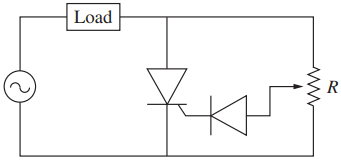
phase-control circuit.
Half-wave Variable-resistance Phase-control Circuit: This circuit is called a half-wave variable-resistance phase-control circuit. Because a SCR is unidirectional, the circuit only affects the positive portion of the AC signal or half-wave.
When the voltage crosses the zero mark, the SCR stops conducting. As seen in Figure 3, the gate current to the SCR is controlled by a potentiometer through a diode. The diode is used to prevent the negative half of the AC signal from affecting the gate.
Changing the resistance of the potentiometer causes the gate current to change. Since the applied voltage is sinusoidal (not constant), this causes the gate to trigger at different times with respect to the AC signal (hence the name phase control).
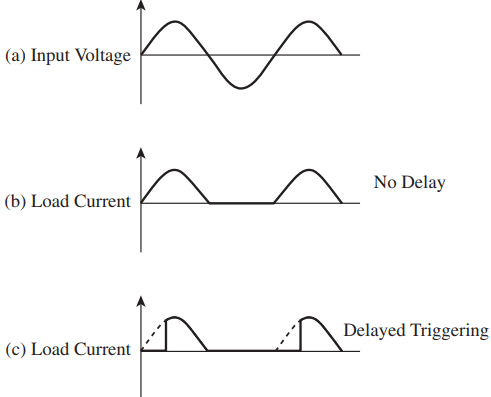
half-wave variable resistance
phase-control circuit.
If the triggering occurs at the beginning of the positive half of the voltage signal, then all of the current is passed, as shown in Figure 4(b).
If the triggering occurs at a later time, then only a portion of the current is passed, as shown in Figure 4(c).
Since the duration of the current passed affects the speed or delivered power to the controlled device, the SCR offers a simple way to control the power.
Crowbar Circuit: Another application of SCRs is to use them in overvoltage protection circuits. The circuit shown in Figure 5 is commonly referred to as a crowbar circuit.
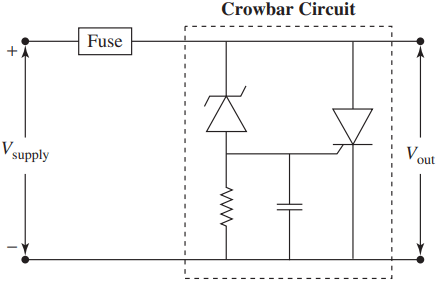
over-voltage protection.
It is used to protect from power surges or power-supply malfunction problems. It basically uses a Zener diode in combination with a SCR. The Zener voltage should be selected to be higher than the nominal supply voltage.
When the Zener diode switches on due to over-voltage condition, this causes a current to flow to the gate of the SCR. The SCR will conduct, allowing a large current to flow, thus acting as a short circuit and blowing the circuit fuse. The capacitor is added to prevent the SCR from triggering when powered up.
Because of component tolerances, this circuit will operate reliably only if the over-voltage is 30 to 40% higher than the nominal voltage.
Speed Control of DC Shunt Motor by SCR: The figure shows an SCR circuit that can be used for the speed control of dc shunt motor. In this circuit, the supply voltage to the armature can be varied by varying the conduction angle of the SCR, so the smooth variation in speed is possible.
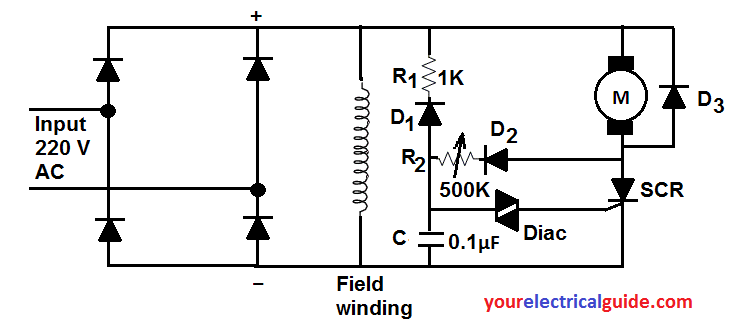
Here the diac is used to trigger the SCR. The bridge rectifier is used for full-wave rectification. The field winding is connected across the pulsating output and voltage to the armature is controlled by varying R2.
At the end of each cycle capacitor, C is completely discharged. The capacitor begins to charge in each cycle through resistance R2, diode D2, and the armature winding.
When the capacitor is charged up to the breakdown voltage of diac, a trigger pulse is delivered to the SCR gate turning it ON. The pulsating voltage is applied to the armature.
The SCR is turned OFF at the end of each half-cycle, when the anode current will be less than the holding current. At the end of each half-cycle capacitor discharges through D1, R1 and field winding i.e. at the beginning of each cycle, the capacitor voltage is zero.
The time taken by the capacitor C1 to charge up to the breakdown voltage of diac is controlled by the resistance R2. If R2 is lower the firing angle will be small means the more voltage will be applied across the armature i.e. if R2 is low the motor speed will be high, if R2 is high the motor speed will be low.
The diode D3 is a freewheeling diode. To know about its function please follow the link.
Related Posts
- Operation of Thyristors
- Static Characteristics of SCR | Thyristor
- Silicon Controlled Rectifier Function
- Applications & Characteristics of SCR
- SCR Selection Criteria
- Thyristor | SCR Specifications and Ratings
- Operation of Triac & GTO
- Triac Working
- Characteristics, Operation, & Construction of IGBT
- Freewheeling Diode in Controlled Rectifier
- Reverse Recovery Characteristics of Power Diode